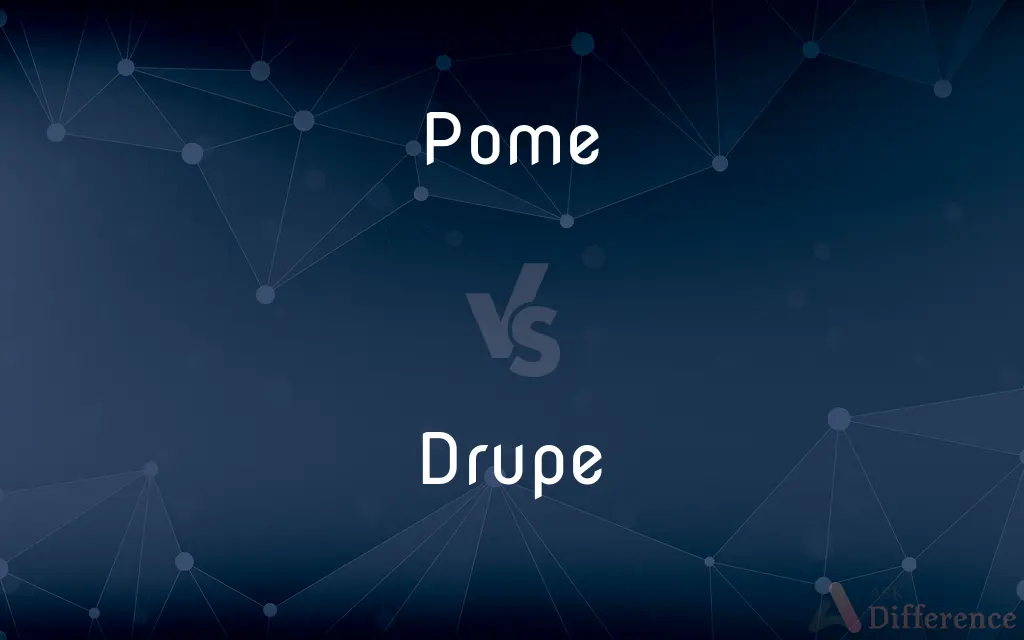Pome vs. Drupe — What's the Difference?
By Urooj Arif & Fiza Rafique — Updated on March 26, 2024
A pome is a fruit with a core containing seeds, like apples, while a drupe has a single hard pit or stone, such as peaches.

Difference Between Pome and Drupe
Table of Contents
ADVERTISEMENT
Key Differences
Pomes, such as apples and pears, are characterized by their fleshy outer layer and a central core containing seeds. This structure is typical of fruits in the Rosaceae family. Whereas drupes, including cherries, plums, and peaches, feature a single seed encased in a hard endocarp surrounded by a fleshy or pulpy exterior. This distinctive feature categorizes them separately in the realm of fruit types.
Pomes usually have a relatively smooth skin and a firm flesh that is eaten along with the skin. This edible part is derived from the ovary as well as surrounding floral parts. On the other hand, drupes often have a soft outer flesh that is sometimes peeled before consumption, and their edible portion is primarily the product of the ovary alone.
The cultivation of pomes like apples and pears focuses on varieties that offer a range of flavors, textures, and storage capabilities, catering to different culinary uses and preferences. Whereas the cultivation of drupes emphasizes not only the taste and texture of the flesh but also the ease of stone removal, which is a significant factor for both fresh consumption and processing uses.
In terms of nutritional content, pomes are often rich in dietary fiber and vitamin C, making them a healthy addition to the diet. Drupes, while also nutritious, tend to provide a different profile of vitamins and minerals, such as vitamin A in apricots and antioxidants in cherries.
The propagation methods for pomes and drupes also differ. Pomes are typically propagated through grafting to maintain the characteristics of a particular variety, ensuring consistency in flavor and growth habits. Drupes, however, can be propagated through seed or grafting, but the use of seeds can result in significant variability in the characteristics of the offspring.
ADVERTISEMENT
Comparison Chart
Definition
A fruit with a core of seeds.
A fruit with a single hard pit.
Typical Examples
Apples, Pears
Peaches, Cherries
Edible Part Origin
Ovary and surrounding parts.
Ovary alone.
Skin/Flesh
Smooth skin, firm flesh.
Soft flesh, sometimes peeled.
Nutritional Content
High in dietary fiber and vitamin C.
Varied, often rich in vitamin A and antioxidants.
Propagation
Primarily through grafting.
Seed or grafting, with variability in offspring.
Use in Culinary
Wide range for flavors and textures.
Taste, texture, and stone removal considered.
Compare with Definitions
Pome
A fruit with a central seed-containing core surrounded by edible flesh.
An apple is a classic example of a pome.
Drupe
The flesh can be soft and is sometimes peeled.
The soft, juicy flesh of drupes like cherries is often eaten raw.
Pome
Used in a wide range of culinary applications.
Pomes such as apples are versatile, used in everything from salads to desserts.
Drupe
A fruit with a single hard stone encasing a seed, surrounded by pulp.
Peaches are succulent drupes enjoyed worldwide.
Pome
Characterized by a smooth outer skin and a firm interior.
Pears offer a variety of textures and flavors as pomes.
Drupe
Provides a variety of vitamins and minerals.
Apricots, a type of drupe, are particularly high in vitamin A.
Pome
Often propagated through grafting for consistency.
Grafting ensures that each new apple tree produces the specific variety of pome desired.
Drupe
Propagation can lead to variability without grafting.
Planting a drupe stone might yield a tree that does not replicate the parent's fruit exactly.
Pome
Rich in dietary fiber and vitamin C.
Eating a pome like an apple provides essential nutrients.
Drupe
Considerations for culinary use include stone removal.
The ease of removing the stone from drupes like plums affects their use in cooking.
Pome
In botany, a pome is a type of fruit produced by flowering plants in the subtribe Malinae of the family Rosaceae. Well-known pomes include the apple, pear, and quince.
Drupe
In botany, a drupe (or stone fruit) is an indehiscent fruit in which an outer fleshy part (exocarp, or skin, and mesocarp, or flesh) surrounds a single shell (the pit, stone, or pyrena) of hardened endocarp with a seed (kernel) inside. These fruits usually develop from a single carpel, and mostly from flowers with superior ovaries (polypyrenous drupes are exceptions).
Pome
A fleshy fruit, such as an apple, pear, or quince, having several seed chambers and an outer fleshy part largely derived from the hypanthium.
Drupe
A fleshy fruit, such as a peach, plum, or cherry, usually having a single hard stone that encloses a seed. Also called stone fruit.
Pome
(botany) A type of fruit in which the often edible flesh arises from the swollen base of the flower and not from the carpels.
The best-known example of a pome is the apple.
Drupe
(botany) a kind of fruit, with a fleshy exterior, formed from the exocarp and mesocarp, surrounding a hardened endocarp which protects the seed.
Pome
(Roman Catholic) A ball of silver or other metal, filled with hot water and used by a Roman Catholic priest in cold weather to warm his hands during the service.
Drupe
A fruit consisting of pulpy, coriaceous, or fibrous exocarp, without valves, containing a nut or stone with a kernel. The exocarp is succulent in the plum, cherry, apricot, peach, etc.; dry and subcoriaceous in the almond; and fibrous in the cocoanut.
Pome
To grow to a head, or form a head in growing.
Drupe
Fleshy indehiscent fruit with a single seed: e.g. almond; peach; plum; cherry; elderberry; olive; jujube
Pome
A fruit composed of several cartilaginous or bony carpels inclosed in an adherent fleshy mass, which is partly receptacle and partly calyx, as an apple, quince, or pear.
Pome
A ball of silver or other metal, which is filled with hot water, and used by the priest in cold weather to warm his hands during the service.
Pome
To grow to a head, or form a head in growing.
Pome
A fleshy fruit (apple or pear or related fruits) having seed chambers and an outer fleshy part
Common Curiosities
Can you eat the skin of pomes and drupes?
The skin of pomes is typically eaten, while the flesh around the drupe's stone is consumed, sometimes after peeling.
What is a pome?
A pome is a type of fruit characterized by a core of seeds surrounded by edible flesh, such as an apple.
How are drupes propagated?
Drupes can be propagated by seeds or grafting, but seeds may lead to variability in the offspring.
How do pomes and drupes differ in structure?
Pomes have a seed-containing core, while drupes have a single hard stone encasing the seed.
What are common examples of drupes?
Peaches, cherries, and plums are popular drupes.
What nutritional benefits do drupes offer?
Drupes provide a variety of vitamins and minerals, such as vitamin A and antioxidants.
How are pomes propagated?
Pomes are usually propagated through grafting to maintain variety characteristics.
Why is grafting important for pome cultivation?
Grafting ensures consistency in the fruit's flavor and growth habits in pomes.
What is a drupe?
A drupe is a fruit with a single hard pit or stone inside, surrounded by juicy flesh, like a peach.
How are pomes and drupes used in cooking?
Pomes are versatile in culinary uses, while drupes are prized for their flavor and texture, with considerations for stone removal.
Are the seeds of pomes and drupes edible?
Generally, the seeds of pomes and the pits of drupes are not eaten due to their hard nature and, in some cases, toxicity.
What are common examples of pomes?
Apples and pears are common examples of pomes.
How does the taste of pomes compare to drupes?
Taste varies widely among both pomes and drupes, ranging from sweet to tart, but drupes often have a juicier, softer texture.
What nutritional benefits do pomes offer?
Pomes are often high in dietary fiber and vitamin C.
Can the method of propagation affect the fruit's characteristics?
Yes, the method of propagation, especially in drupes, can affect the fruit's characteristics, leading to variability without precise methods like grafting.
Share Your Discovery

Previous Comparison
Bacchanalia vs. Saturnalia
Next Comparison
Protoboard vs. BreadboardAuthor Spotlight
Written by
Urooj ArifUrooj is a skilled content writer at Ask Difference, known for her exceptional ability to simplify complex topics into engaging and informative content. With a passion for research and a flair for clear, concise writing, she consistently delivers articles that resonate with our diverse audience.
Co-written by
Fiza RafiqueFiza Rafique is a skilled content writer at AskDifference.com, where she meticulously refines and enhances written pieces. Drawing from her vast editorial expertise, Fiza ensures clarity, accuracy, and precision in every article. Passionate about language, she continually seeks to elevate the quality of content for readers worldwide.















































